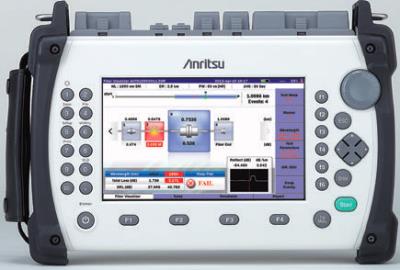
|
|
The Anritsu MT9083B2 ACCESS Master High Performance OTDR, Optical Power Meter, and Visible Light Source provides measurement functions and performance required for optical fiber construction and maintenance in a compact, lightweight, all-in-one unit. It features a 7-inch widescreen TFT-LCD display for use both indoors and outdoors, enhanced battery operation time (up to 12 hours), increased operating temperature range (-10° to +50° C) and new short-cut function keys. The OTDR port also functions as an integrated power meter and a stabilized light source that provides continuous wave, 270 Hz, 1 kHz and 2 kHz modulations for easy fiber identification. This is standard equipment on all single mode models.
General Specifications.
Data Storage: Internal memory 1 GB (50,000 traces), External memory (USB) up to 32 GB.
Sampling Points: Normal 5001, High density 20001 or 25001, Very high density 100,001 or 150,001.
Sampling Resolution: 5 cm (min).
Reflectance Accuracy Single mode: ±2 dB, multimode: ± 4 dB.
Distance Accuracy: ± 1 m ± 3 x measurement distance x 10-5 ±marker resolution (excluding IOR uncertainty).
Distance Range:
Single mode: 0.5, 1, 2.5, 5, 10, 25, 50, 100, 200, 300 km;
Multimode: 0.5, 1, 2.5, 5, 10, 25, 50, 100 km.
OTDR Specifications (Model Specific).
MT9083B2-053.
Wavelength: 1310/1550 nm ±25 nm.
Fiber Type: Single Mode (SMF) 10/125 μm ITU-T G.652.
Pulse Width: 3, 10, 20, 50, 100, 200, 500, 1000, 2000, 4000, 10000, 20000 ns.
Dynamic Range: 42/41 dB.
Deadzone (Fresnel) (IOR = 1.500000): ≤1 m, ≤80 cm (typ).
Deadzone (Backscatter): ≤5/5.5 m.
MT9083B2-055.
Wavelength: 1310/1550 nm ±25 nm, 1650 nm ±5 nm.
Fiber Type: Single Mode (SMF) 10/125 μm ITU-T G.652.
Pulse Width: 3, 10, 20, 50, 100, 200, 500, 1000, 2000, 4000, 10000, 20000 ns.
Dynamic Range: 42/41/35 dB.
Deadzone (Fresnel) (IOR = 1.500000): ≤1 m, ≤80 cm (typ).
Deadzone (Backscatter): ≤5/5.5/6.5 m.
MT9083B2-056.
Wavelength: 1310/1490/1550 nm ±25 nm.
Fiber Type: Single Mode (SMF) 10/125 μm ITU-T G.652.
Pulse Width: 3, 10, 20, 50, 100, 200, 500, 1000, 2000, 4000, 10000, 20000 ns.
Dynamic Range: 42/41/41 dB.
Deadzone (Fresnel) (IOR = 1.500000): ≤1 m, ≤80 cm (typ).
Deadzone (Backscatter): ≤6/6.5/6.5 m.
MT9083B2-057.
Wavelength: 1310/1550/1625 nm ±25 nm.
Fiber Type: Single Mode (SMF) 10/125 μm ITU-T G.652.
Pulse Width: 3, 10, 20, 50, 100, 200, 500, 1000, 2000, 4000, 10000, 20000 ns.
Dynamic Range: 40/39/38 dB.
Deadzone (Fresnel) (IOR = 1.500000): ≤1 m, ≤80 cm (typ).
Deadzone (Backscatter): ≤6/6.5/7.5 m.
MT9083B2-058.
Wavelength: 1310/1490/1550/1625 nm ±25 nm.
Fiber Type: Single Mode (SMF) 10/125 μm ITU-T G.652.
Pulse Width: 3, 10, 20, 50, 100, 200, 500, 1000, 2000, 4000, 10000, 20000 ns.
Dynamic Range: 42/41/41/40 dB.
Deadzone (Fresnel) (IOR = 1.500000): ≤1 m, ≤80 cm (typ).
Deadzone (Backscatter): ≤7/7.5/7.5/8.5 m.
MT9083B2-063.
Wavelength: 1310/1550 nm ±25 nm, 850/1300 ±30 nm.
Fiber Type: HYBRID (SMF/MMF).
Pulse Width:
SMF 3, 10, 20, 50, 100, 200, 500, 1000, 2000, 4000, 10000, 20000 ns;
MMF (1310 nm) 3, 10, 20, 50, 100, 200, 500, 1000, 2000, 4000 ns;
MMF (850 nm) 3, 10, 20, 50, 100, 200, 500 ns;
Dynamic Range: 42/41 dB (1310/1550), 29/28 dB (850/1300).
Deadzone (Fresnel) (IOR = 1.500000): ≤1 m, ≤80 cm (typ).
Deadzone (Backscatter): ≤5/5.5, ≤4/5 m.
Light Source Specifications.
Wavelength: Same as OTDR.
Spectral Width:
≤5 nm (1310 nm);
≤10 nm (850/1300/1490/1550/1625 nm);
≤3 nm (1650 nm).
Wavelength Accuracy: 850/1300/1310/1490/1550/1625 nm: ±30 nm, 1650 nm: ±5 nm.
Output Power: 17 -5 ±1.5 dBm.
Output Stability: ±0.1 dB.
Modes of Operation: CW, 270 Hz, 1 kHz, 2 kHz.
Power Meter Specifications.
Maximum Input: +10 dBm.
Measurement Range: -50 to -5 dBm.
Accuracy: ±6.5%.
|